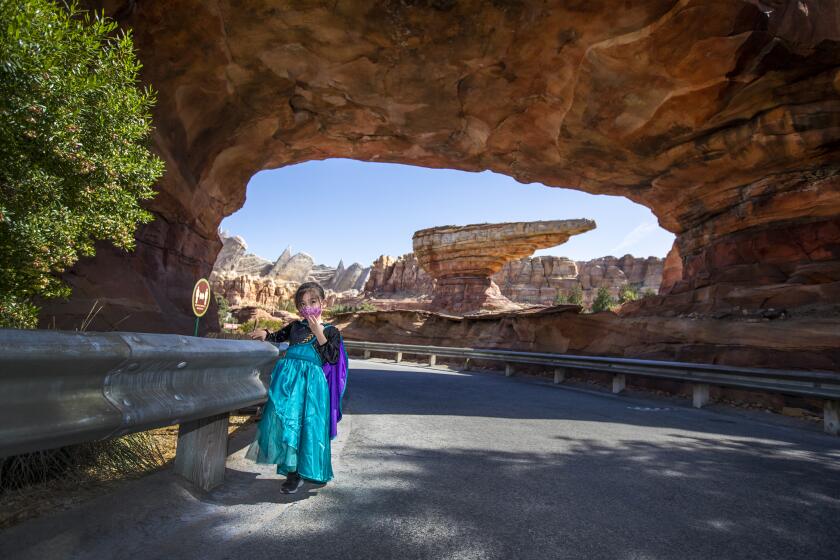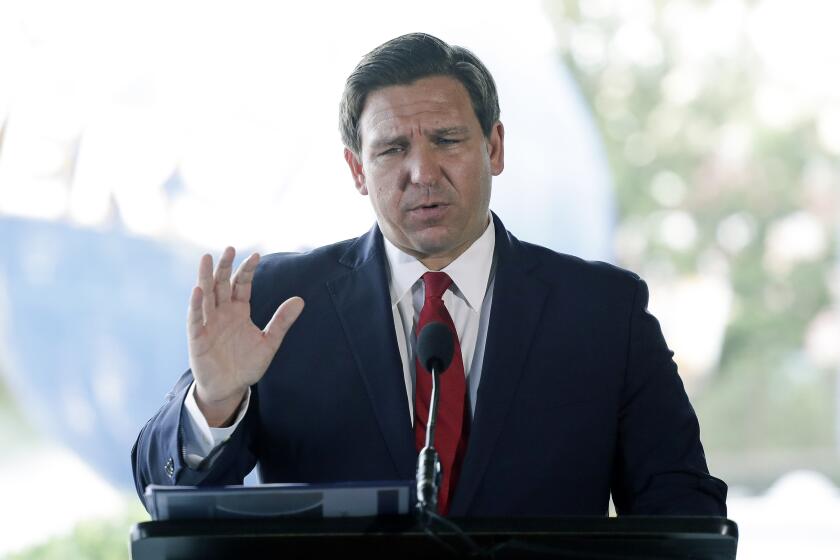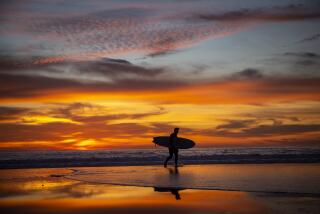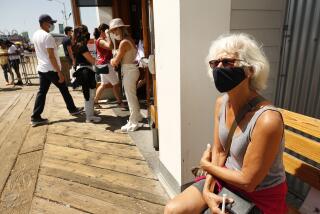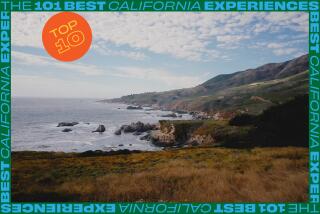Florida reopened to tourists early. Now, California is trying to catch up
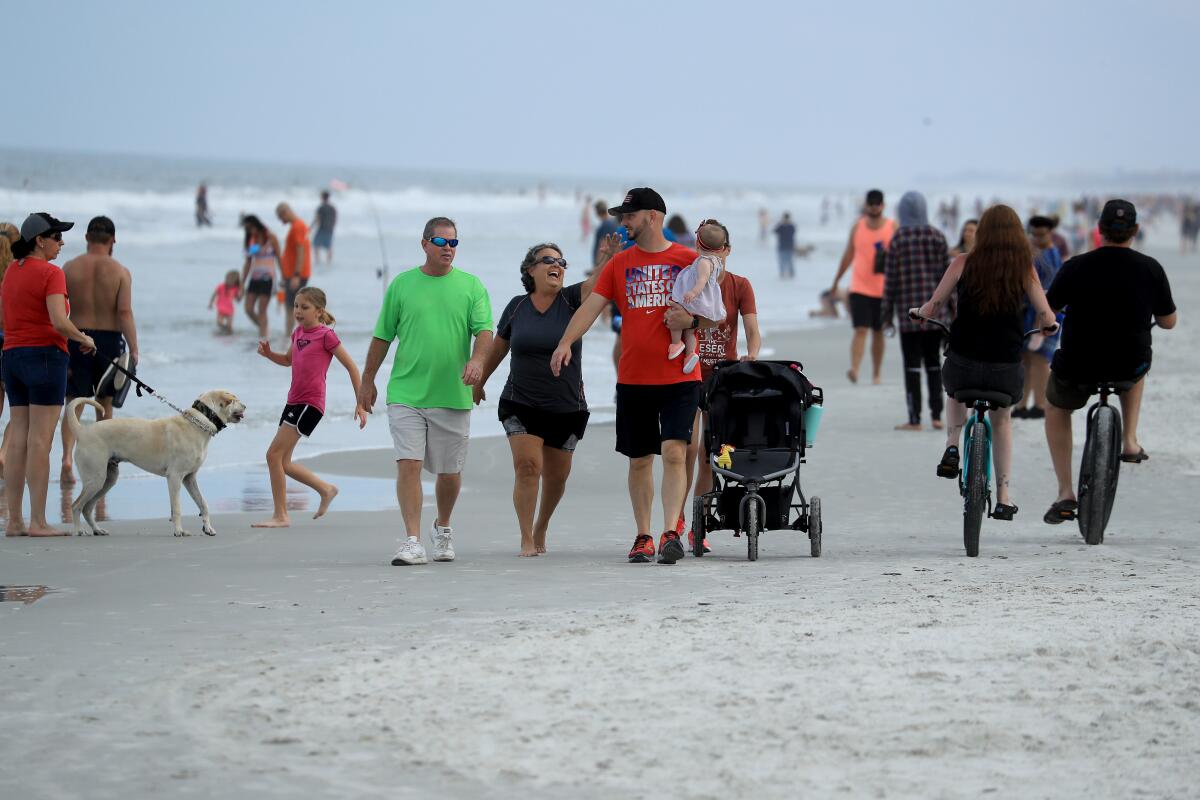
- Share via
Florida has Disney World and the Keys.
California has Disneyland and Yosemite National Park.
For years, the Sunshine State and the Golden State have been fierce competitors in the battle for domestic and international tourists and the hundreds of billions of dollars they spend while vacationing.
In the last few years, California has dominated Florida in this category, holding a more than 2-1 lead in the number of visitors and collecting about 50% more in annual tourist spending.
When the pandemic hit, the two states had different responses to combat the deadly virus: California imposed strict restrictions about masking and physical distancing, while Florida adopted a more relaxed approach that allowed indoor dining and made mask-wearing optional.
California shut down hotels, theme parks and tourist attractions for more than a year, essentially closing the nation’s top tourist destination as a public health strategy. Florida’s tourism industry barely skipped a beat, launching advertising campaigns to draw visitors throughout most of the last year.
The deer, bobcats, coyotes and bears no longer have to deal with the hordes of camera-toting tourist vying to capture nature. They now roam unfettered.
As a result, Florida is now surpassing California in three key tourism vitality indicators: total travel spending, hotel occupancy rates and the number of airline seats on planes bringing in visitors.
“We are thriving while other states are struggling, and I attribute that largely to the bold, aggressive tactics that we employed very early,” said Dana Young, executive director of Visit Florida, the state’s marketing organization.
But with the rollout of COVID-19 vaccines, California is now welcoming visitors back, and the state’s tourism leaders hope to return California to its place as the nation’s most popular destination. To do that, they are spending $95 million to promote the state this fiscal year, compared with about $36 million in pre-pandemic years.
Although the spread of the Delta variant is increasing coronavirus cases across the country and in California, tourism officials hope the state’s high vaccination rates and low coronavirus cases will appeal to health-minded travelers.
“We are the underdog right now, but the future looks bright,” said Caroline Beteta, president and chief executive of Visit California, the nonprofit marketing group for the state.
In 2019, California attracted 286 million domestic and international visitors, who spent $144 billion while visiting, according to Visit California. Florida hosted 131 million visitors, who spent $99 billion, according to Visit Florida.
As COVID-19 cases rose, California instituted shelter-in-place orders and closed state parks, beaches, theme parks, bars, indoor restaurants, zoos, museums and theaters, among other favorite tourist haunts. Leisure travel was forbidden for several months.

Visit California halted its advertising campaign in March 2020, holding off until late March 2021 to relaunch the efforts.
Beaches began to reopen in fall 2020, but state and national parks remained closed until about January 2021. Disneyland, Universal Studios Hollywood and other theme parks remained closed for at least 13 months.
The reservation system is daunting and without FastPasses, there will be lines. But surviving a day at the Disney parks has always been part of the fun.
California’s visitor numbers dropped by about 50% to 140.6 million in 2020, according to Visit California. The state’s share of the nation’s total visitor market dropped by 26% in 2020.
In Florida, most tourist destinations reopened much sooner. Walt Disney World in Orlando closed for only about four months. Most Florida counties closed their beaches or kept them open under restricted conditions for a month or two before beachgoers were allowed back.
Visit Florida halted its advertising campaign in March 2020, only to relaunch it five months later. The promotional campaign was expanded in October to target markets within 700 miles of Florida. In December, Visit Florida launched a winter marketing campaign.
Despite the pandemic, Florida drew about 80 million visitors in 2020, a 40% decline from the previous year, according to Visit Florida. But the state’s share of the visitor market grew by nearly 2% in 2020. Texas and other states had much larger increases in visitor market share, according to a study by Visit California.
“We have been very, very aggressive in our marketing and we have never looked back,” Young said.
Florida Gov. DeSantis is running a victory lap over his COVID-19 response as the press plays along.
California and Florida draw many of their visitors from neighboring states, but both covet the long-haul travelers from Chicago, New York and other East Coast cities because they tend to spend more and stay longer.
California hopes to rebound from the pandemic with its “What if, California” campaign, which includes online and television ads. The funding is also expected to promote culinary tourism, family travel, winter destinations, a new emphasis on visiting California’s urban cores and a dedicated $4.5 million to bring back business and group travel.
“We have some ground to make up, that’s for sure,” Beteta said.
California’s promotional campaign doesn’t mention the pandemic, but some travelers say the state’s high vaccination rate and low case numbers make it more appealing than other vacation spots, such as Florida.
Roger Thompson, vice president for student services and enrollment at the University of Oregon, visited Southern California for the Fourth of July weekend with his family. They spent time watching a fireworks display over the pier in Huntington Beach and hit up several restaurants in Long Beach.
He said he considered visiting Florida but chose the Golden State for his first out-of-state trip since 2019 because of the beaches and restaurants, as well as its high vaccination rates and low coronavirus cases.
“California seemed to be the spot where COVID is under control, and they have gorgeous beaches,” Thompson said. “We had a great time.”
More to Read
Inside the business of entertainment
The Wide Shot brings you news, analysis and insights on everything from streaming wars to production — and what it all means for the future.
You may occasionally receive promotional content from the Los Angeles Times.

